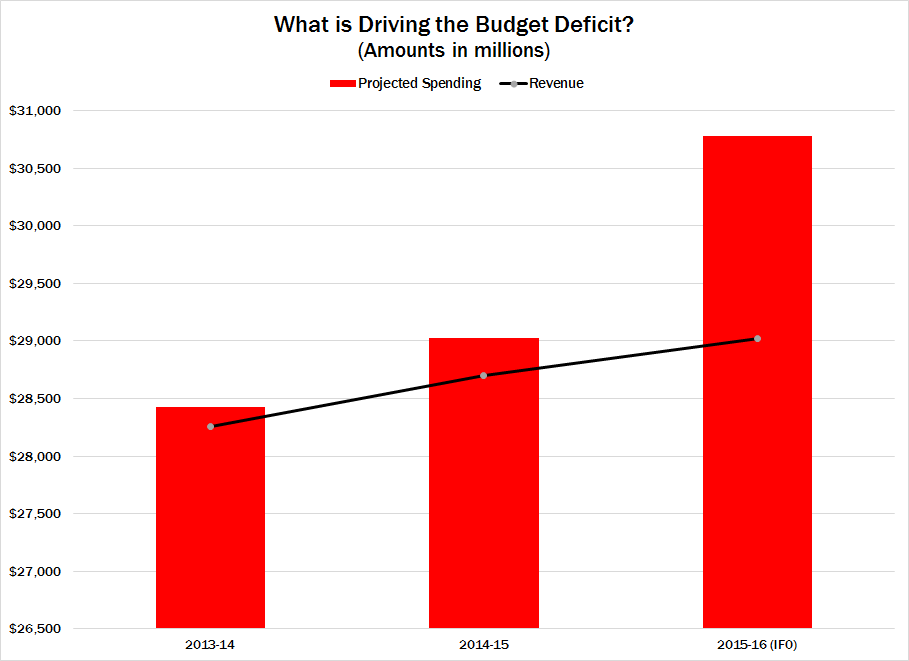Memo

Five Steps Toward a Balanced Budget
The consequences of overspending have plagued Pennsylvania for years. This year is no different. Lawmakers are tasked with eliminating a projected budget deficit of nearly $1.7 billion, according to forecasts from the Independent Fiscal Office (IFO). Without reform, this structural deficit could exceed $2.5 billion by 2020. Despite these daunting predictions, lawmakers have the ability to pass a balanced budget that respects three important principles:
- Protect families and business from tax increases.
- Avoid overspending. The state should not spend more than it collects in revenue.
- Limit spending growth to the Taxpayer Protection Act index of inflation plus population growth.
As the chart below indicates, the primary driver of the deficit is projected spending growth. The IFO’s budget forecast assumes $1.8 billion in General Fund spending growth next fiscal year.

In other words, it’s possible to balance the General Fund Budget by simply freezing spending at the current level—already the highest in state history. Such spending restraint would obviate the need to raise taxes on working people.
Candidly, the state’s budget problems are not the result of Pennsylvanians paying too little in taxes. Families and businesses in the state already labor under the 10th highest state and local tax burden in the country. The problem is excessive spending. State government has been spending beyond the means of taxpayers for years. In 1970, state government spent nearly $8,500 per family of four. Today, it spends approximately $22,350 per family of four—a 162 percent increase (adjusted for inflation).
Raising taxes may balance the budget in the short term, but it will prove detrimental for family budgets across the state, as they have to make do with less. Instead of taking more in taxes from Pennsylvanians, government must prioritize its resources and address the real problem confronting the state: overspending.
To solve this problem, and move the state toward a balanced budget, we have proposed the following five steps:
1. Reduce Corporate Welfare: Corporate welfare is public money given directly to new or established businesses in the name of economic development, usually in the form of cash payments or tax credits. However, this type of government spending tends to do more harm than good. Instead of allowing businesses to make investment decisions with their own money, government taxes away their money, spending it less efficiently on other programs, which slows economic growth. In fact, since 2007, states spending the most on corporate welfare saw their economies grow at a slower rate than states that spent the least.
The Commonwealth Foundation has identified nearly $700 million in corporate welfare, which, if eliminated, would lead to better economic growth and end the perverse practice of forcing businesses to subsidize their own competition.
2. Education Funding Reform: The IFO predicts the education budget will grow by 6.9 percent, or $797 million in 2015-2016. Nearly 75 percent of this increase is driven by pension costs. If lawmakers froze non-pension related education spending, taxpayers would save approximately $200 million. By coupling this freeze with education funding reform—specifically, shifting to a Weighted Student Funding (WSF) model—school districts with growing student populations would receive needed financial support without requiring more dollars from taxpayers.
Freezing non-pension related spending and moving to a WSF formula would protect working people from higher taxes and help shrink the projected deficit. At the same time, it would keep in place payments critical to funding teachers’ pensions. Even with the spending freeze, the state’s education budget would reach a record high for the 2015-2016 fiscal year.
3. Slow the Growth of Welfare Spending: The second largest projected spending increase is in the Human Services budget (formerly Public Welfare). In 2015-2016, the Human Services budget is projected to grow by 5.5 percent or $618 million, according to IFO estimates.
This spending growth greatly exceeds the rate of inflation and population growth (a combined 1.71 percent average over the past three years). If the department were taken off autopilot and planned spending increases were reduced by half, taxpayers would save $300 million. This reduction in the growth of spending would be less than three percent of the entire human services budget.
How can we do this? To help reduce spending in 2012, state lawmakers gave counties additional flexibility over seven human services programs in exchange for a reduction in funding. The tradeoff lowered administration costs and allowed counties to focus on the most effective programs. Today, at least 30 counties are participating in the program. Applying this model to other programs could lead to lower costs.
Performance-based budgeting is another reform to consider. Human Services programs track the number of people utilizing services but rarely consider how many become more independent. Additional budget appropriations can be tied to the number of people who no longer need assistance, rather than assuming more dollars will create a public benefit.
4. Reprioritize Funds: During budget season, a great deal of attention is given to the General Fund Budget, but Pennsylvania’s total budget is much larger. In fact, there are more than 158 “special” and “other” state funds with expenditures totaling more than $18 billion this year. This is in addition to the $29 billion General Fund Budget and more than $24 billion in federal funds for state-run programs, all of which comprise the total operating budget. Given the state’s fiscal situation, it makes sense to reprioritize dollars from “special” and “other” state funds, directing them to more pressing needs in the General Fund Budget.
5. End the Prevailing Wage Mandate: According to Census data, Pennsylvania state and local governments spent $10.7 billion on construction in 2012. Thanks to Pennsylvania’s “prevailing wage” mandate, the price of many of these construction projects were artificially increased by an estimated 10 to 30 percent.
If this outdated mandate was eliminated, state and local governments could use the savings—upwards of $1 billion annually—to fund other areas of the budget. Particularly hard hit are school districts, who are forced to pay more for school construction and repair because of state mandates. Allowing school districts flexibility from this mandate would free up education dollars to go back in the classroom.
These reforms are by no means exhaustive, but they would move our state in a fiscally responsible, pro-growth direction after years of profligate spending, which have failed to revive our historically weak economy.
After decades of focusing on revenue, it’s time to restrain excessive government spending and job-killing taxes, and transform Pennsylvania into a state of opportunity again.
# # #
To find more information on the Pennsylvania State Budget, visit CommonwealthFoundation.org/Budget